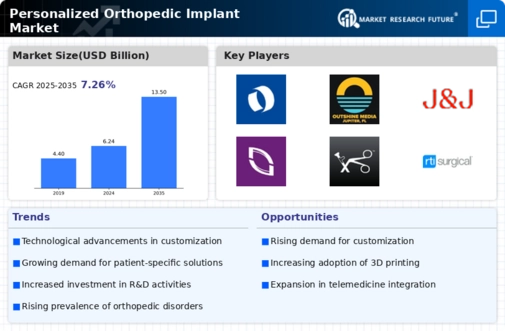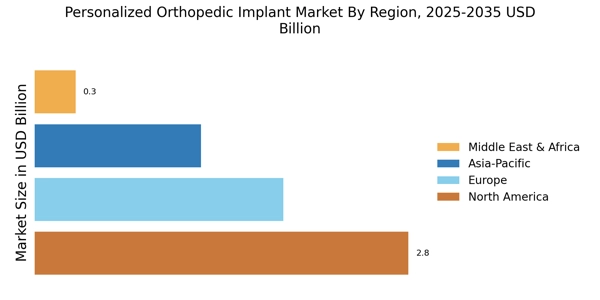Increased Focus on Patient Outcomes
There is a notable shift towards prioritizing patient outcomes in the healthcare sector, which is influencing the Personalized Orthopedic Implant Market. Healthcare providers are increasingly recognizing the importance of personalized treatment plans that consider the unique needs and preferences of patients. This focus on outcomes is driving the adoption of customized orthopedic implants, as they are associated with higher satisfaction rates and improved recovery times. Data suggests that personalized implants can reduce the risk of complications and enhance overall patient quality of life. As healthcare systems continue to emphasize value-based care, the demand for personalized orthopedic solutions is likely to grow, further propelling the Personalized Orthopedic Implant Market.
Advancements in Biocompatible Materials
The development of advanced biocompatible materials is transforming the landscape of the Personalized Orthopedic Implant Market. Innovations in materials science have led to the creation of implants that not only integrate better with human tissue but also reduce the risk of rejection and complications. These materials, such as titanium alloys and bioactive ceramics, are designed to enhance the longevity and performance of orthopedic implants. As research continues to unveil new possibilities in material properties, the market is expected to witness a shift towards implants that offer superior functionality and patient compatibility. This trend is likely to stimulate growth within the Personalized Orthopedic Implant Market as manufacturers seek to leverage these advancements.
Rising Incidence of Orthopedic Disorders
The prevalence of orthopedic disorders, including osteoarthritis and fractures, is on the rise, significantly impacting the Personalized Orthopedic Implant Market. As populations age and lifestyles become more sedentary, the demand for orthopedic interventions is expected to escalate. Recent statistics indicate that approximately 30% of adults over the age of 65 experience some form of arthritis, leading to an increased need for joint replacement surgeries. This growing patient population is likely to drive the demand for personalized orthopedic implants, as healthcare providers seek solutions that cater to the specific needs of these individuals. Consequently, the Personalized Orthopedic Implant Market is poised for substantial growth in response to these demographic trends.
Technological Innovations in Customization
The Personalized Orthopedic Implant Market is experiencing a surge in technological innovations that facilitate the customization of implants. Advanced manufacturing techniques, such as 3D printing and computer-aided design, enable the creation of implants tailored to the unique anatomical structures of individual patients. This level of personalization not only enhances the fit and comfort of the implants but also improves surgical outcomes. According to recent data, the market for 3D-printed orthopedic implants is projected to grow at a compound annual growth rate of over 20% in the coming years. As these technologies become more accessible, the demand for personalized solutions is likely to increase, driving growth in the Personalized Orthopedic Implant Market.
Growing Investment in Research and Development
Investment in research and development is a critical driver for the Personalized Orthopedic Implant Market. As companies strive to innovate and improve their product offerings, increased funding is being directed towards the development of new technologies and materials. This investment is essential for advancing the capabilities of personalized orthopedic implants, enabling manufacturers to create solutions that meet the evolving needs of patients and healthcare providers. Recent reports indicate that R&D spending in the orthopedic sector is expected to rise significantly, reflecting the industry's commitment to enhancing patient care. As a result, the Personalized Orthopedic Implant Market is likely to benefit from a continuous influx of innovative products and solutions.


















Leave a Comment